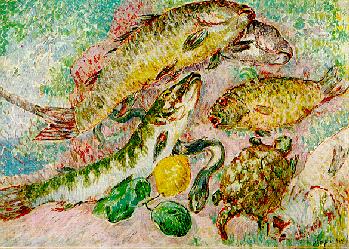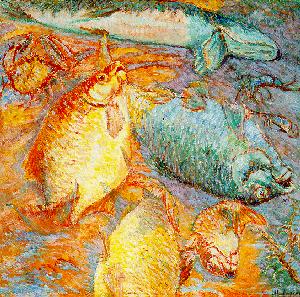
Oil on canvas, 89 x 127 cm.
Collection of Mme A.K. Larionov, Paris.

 The Fish (often called Fishes), painted by Mikhail Larionov in 1906, was exhibited for the first time in 1909 as a part of the second Franco-Russian exhibition sponsored by the Golden Fleece. The painting shares particular qualities of color, light, and rhythm with many other works by painters of the
Blue Rose group (Kuznetsov, Iakulov, Sar'ian, Goncharova, and brothers Miliuti). The blue-grey tones, characteristic of this period, are intermingled with light pinks, greens, and yellows to create a harmonious color scheme, held together by the dappling technique reminiscent of the French impressionists. An almost dancing rhythm seems to unify the shapes within one spatial plane. The hidden light source and liquid, fluid atmosphere employed in the works of the
Blue Rose artists combine agreeably with Larionov's brushstrokes; in fact, on the left side of the painting the brushstrokes even imitate the scales on the fish, adding to the visual unity of the composition. Unlike the darker, more pessimistic or melancholy works of Borisov-Musatov, Larionov's work imparts a light, almost exuberant feeling of ease and freedom. The nonspecific background adds a subtle sense of mystery to the harmony of the scene. Is the fish on someone's kitchen table, ready to be prepared as a meal, or is it depicted a few moments after it has been caught, when the net of a fisherman opens and reveals the wonderful variety of underwater life? The painting seems to be a whimsical still life with fish, a turtle, an eel , and a lemon; perhaps the lemon is there as a jocular reminder that fish and other frutti di mare usually go well with lemon.
The Fish (often called Fishes), painted by Mikhail Larionov in 1906, was exhibited for the first time in 1909 as a part of the second Franco-Russian exhibition sponsored by the Golden Fleece. The painting shares particular qualities of color, light, and rhythm with many other works by painters of the
Blue Rose group (Kuznetsov, Iakulov, Sar'ian, Goncharova, and brothers Miliuti). The blue-grey tones, characteristic of this period, are intermingled with light pinks, greens, and yellows to create a harmonious color scheme, held together by the dappling technique reminiscent of the French impressionists. An almost dancing rhythm seems to unify the shapes within one spatial plane. The hidden light source and liquid, fluid atmosphere employed in the works of the
Blue Rose artists combine agreeably with Larionov's brushstrokes; in fact, on the left side of the painting the brushstrokes even imitate the scales on the fish, adding to the visual unity of the composition. Unlike the darker, more pessimistic or melancholy works of Borisov-Musatov, Larionov's work imparts a light, almost exuberant feeling of ease and freedom. The nonspecific background adds a subtle sense of mystery to the harmony of the scene. Is the fish on someone's kitchen table, ready to be prepared as a meal, or is it depicted a few moments after it has been caught, when the net of a fisherman opens and reveals the wonderful variety of underwater life? The painting seems to be a whimsical still life with fish, a turtle, an eel , and a lemon; perhaps the lemon is there as a jocular reminder that fish and other frutti di mare usually go well with lemon.
A simple comparison of the The Fish and another painting on a similar theme, Fish at Sunset (1904) could be the proof that the shiny, shimmering, and highly reflective scales of the fish attracted the artist because he was fascinated with the phenomenon of light, which seven years later would lead him to the announcement of his rayonist theory and the abandonment of objective art (at least for a while). The earlier painting also shows a variety of sea creatures -- several large fish, a crab, and a few lobsters. However, the light in both pictures is quite different. In the earlier painting, the light of the sunset casts orangy and reddish tint on the entire left side of the canvas, while the far right side, hidden in the shadow, compliments those warm tones with the blue and green. The choice of such "violent" colors links this painting of Larionov to Russian Neo-primitivism. The later painting, with the light illuminating the entire scene evenly, with a more subdued color scheme and with freer painterly technique, shows Larionov progressive departure from Neo-primitivism and advancement towards Rayonism. [B.B. and A.B.]

